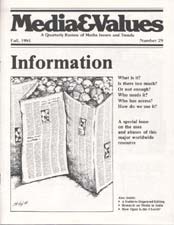Real News vs. the Newsreel
|
Edited from a Mediascope press release, March 1993. Reprinted with permission. This article originally appeared in Issue# 29
|
While the outcry over muzzling the news media and thus controlling public information reached a fever pitch recently with [fill in name of war, political scandal or international incident] keeping reporters and cameras away from the action started long ago — even with television's predecessor, the newsreel.
Although their flickering pictures represented one view of reality for several generations of Americans, newsreels basically ignored some of the most important events of their day. Many shots of Pearl Harbor, for example, were not shown until a year after the Sunday morning attack. And Herbert Hoover was large successful in openly preventing newsreels from covering the marches, protests and souplines of Depression America.
During the 1930's, the Fox Corporation banned scenes of a "controversial nature. . . on which reaction might be divided" from its theaters. Another large firm decreed that "no news from Germany whatever was to be used in the newsreel unless it was revolution against the Hitler regime."
In attempting to censor newsreels, officials were recognizing the power of the filmed image. As a new medium, they were also legally up for grabs. Freedom of the press had been fought for on many battlegrounds, from Zenger on wars, but movies and their related offspring, television (including cable) were still perceived, and financed, as entertainment.
As an appetizer for the upcoming movie, newsreels hardly be allowed to frighten their audiences from the theaters. Yet the drama and pathos of the "reel world" meant that the serious kept intruding along with the bathing beauties and dancing dogs. Certainly few other journalists had to grapple with the problem of the proper musical accompaniment to the silent footage of the first atomic bomb.
Although television news has a different pedigree, its present-day conflicts between news and entertainment values and the proper and fair use of images still relate to the same issues. Consideration of the newsreel has something to teach us of the use of images in shaping and reflecting history. If we really stand back and look, we might even realize that we've still got a long way to go.



